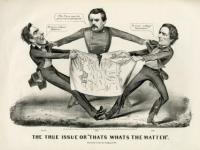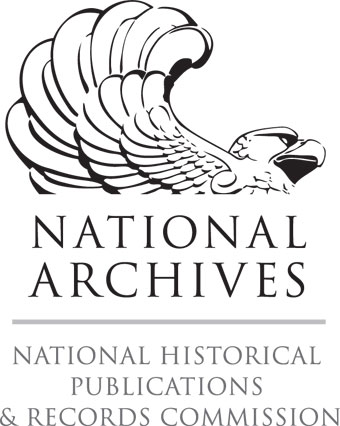Discussing politics in an academic setting will often send up red flags to any classroom instructor, yet incorporating historical political cartoons into a History and Language Arts interdisciplinary lesson can offer a rewarding educational experience in a fun and inviting way. The Historical Society of Pennsylvania is in the process of digitizing hundreds of political cartoons dating from the late 1700s to the early 1900s. The ultimate goal is to share them with the public through an interactive tool on our website. This tool will include a zoom feature as well as information on who is in the cartoon and what the symbols in the cartoon signify.
This website will be an invaluable experience to teachers who can use these new features to teach about historical moments and literacy skills. What better way to teach figurative language than to use a cartoon showing Jefferson Davis and Abraham Lincoln pulling apart a map of the United States (above) or one depicting all of the southern states riding various animals off a cliff to illustrate how Northerners viewed Southern succession. These cartoons are a tangible primary source and an insight into what people were thinking and reading when these events took place. In addition to their historical importance, the irony and symbolism are hard to miss and become important pieces of cultural and political history.
While incorporating political cartoons into our Digital Library, we had discussions with HSP’s Teacher Advisors to think about educational concerns. First, consider the relevancy of the item: Is it on a topic often researched? What is the historical significance? It is national or local? A cartoon on the Civil War or something involving Abraham Lincoln is more likely to be relevant to students than one on an obscure mayor of Philadelphia. At the same time, a cartoon with strong symbolism will stand out regardless of the topic. Next, consider the point of view of the cartoon: Who created it and why? Is it anti-immigrant or racist? Some cartoons are historically relevant, yet unacceptable for a classroom due to the content and message. Therefore, it is important to check the meaning of the cartoon rather than just choose by topic. Lastly, some cartoons are in physically poor condition and, even with the new software, the message can be hard to understand and read. If you find that a cartoon will have to be accompanied by a very detailed explanation and transcription, the point of the cartoon will be lost.
The importance of political cartoons cannot be missed. Their cultural and political significance are more similar to cartoons today than most might imagine. Political cartoons illustrate the culture and opinions of the population living through the event. Cartoons can even take that opinion a step further by explaining their message through visuals that make them more useful to teachers and students who wish to explore different historical topics. With all that being said, when examining how to utilize political cartoons, understand the audience first and the product will be a useful addition to any classroom.


